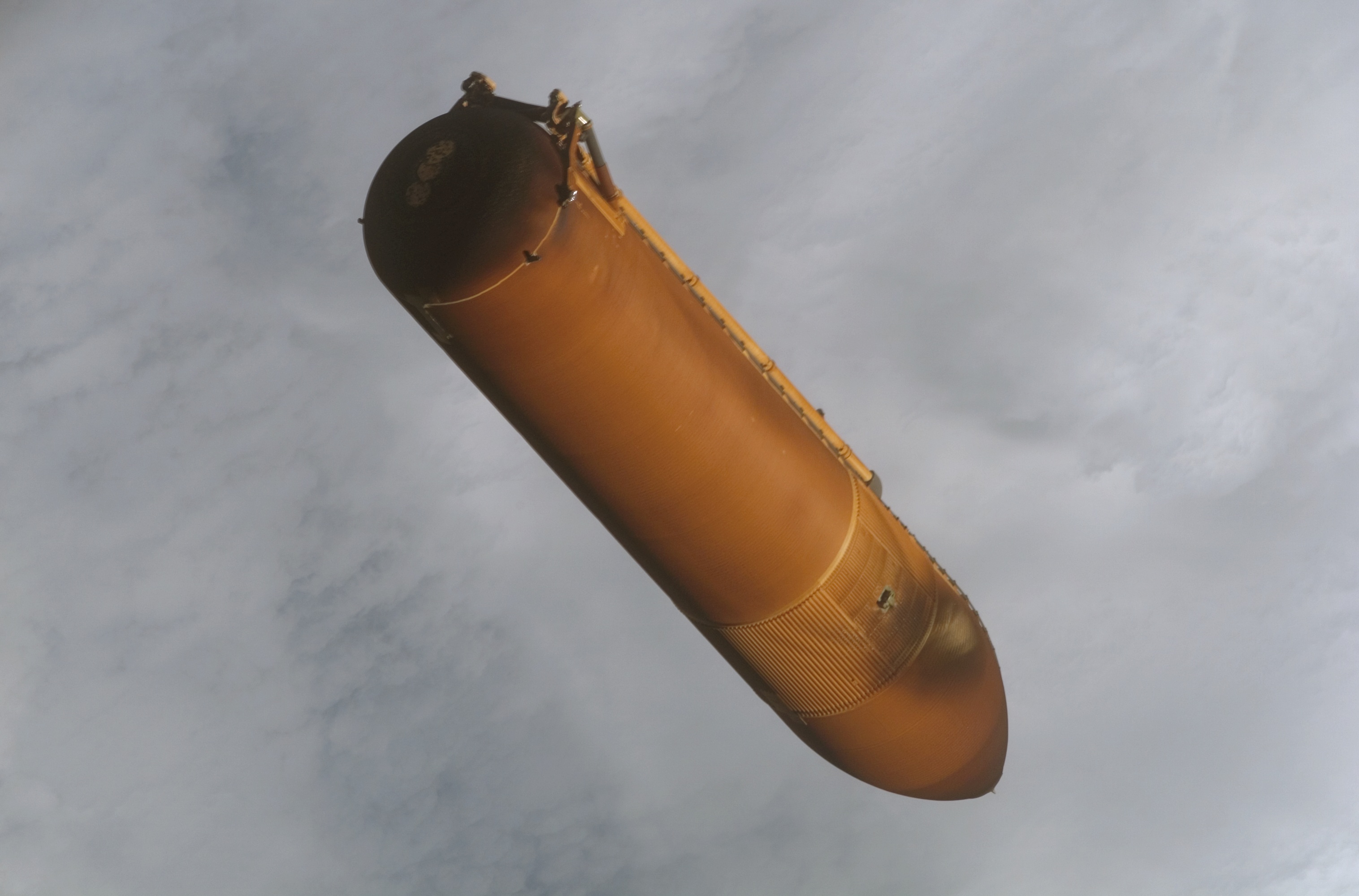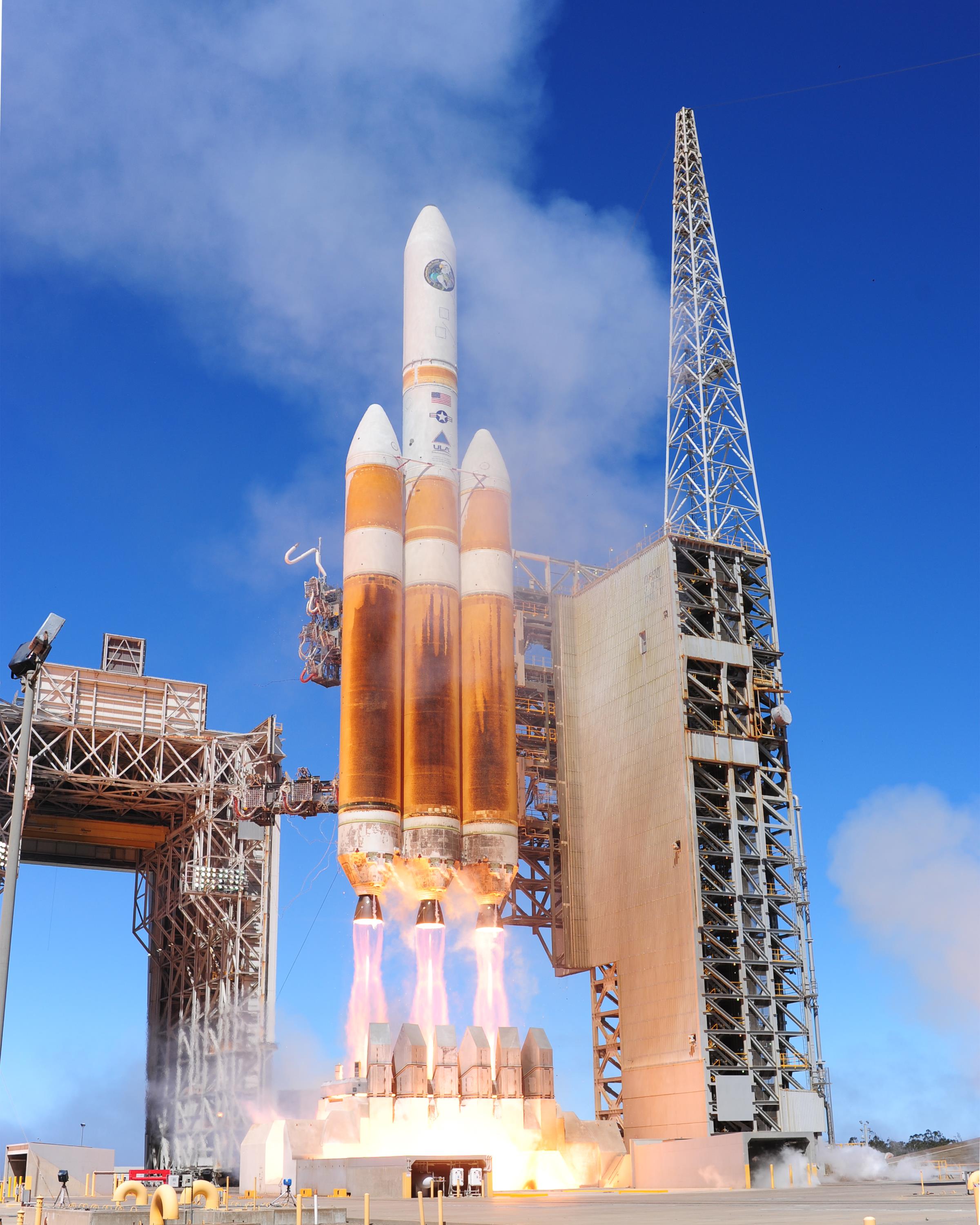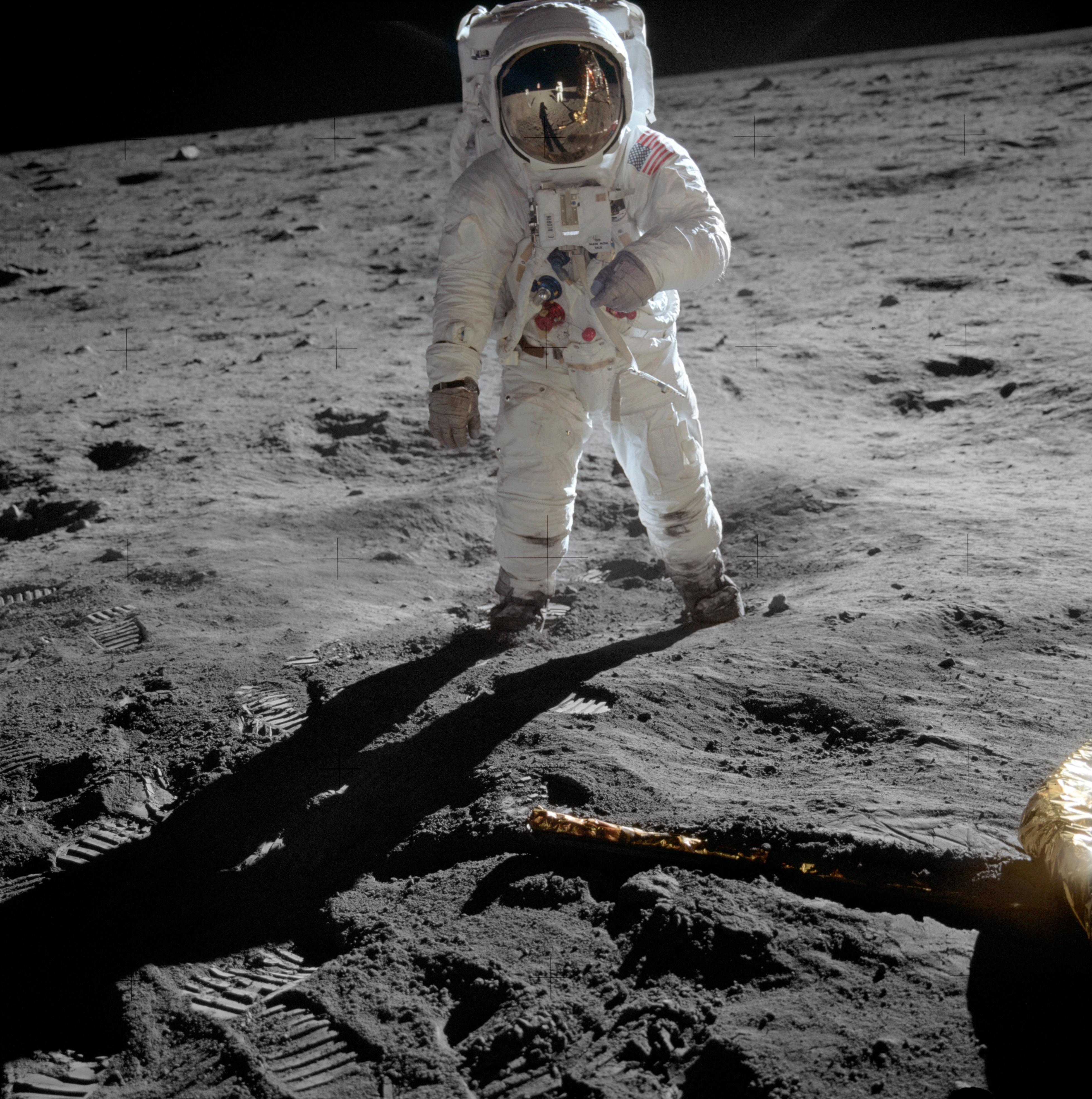|
Ares V
The Ares V (formerly known as the Cargo Launch Vehicle or CaLV) was the planned cargo launch component of the cancelled NASA Constellation program, which was to have replaced the Space Shuttle after its retirement in 2011. Ares V was also planned to carry supplies for a human presence on Mars. Ares V and the smaller Ares I were named after Ares, the Greek god of war. The Ares V was to launch the Earth Departure Stage and Altair lunar lander for NASA's return to the Moon, which was planned for 2019. It would also have served as the principal launcher for missions beyond the Earth-Moon system, including the program's ultimate goal, a crewed mission to Mars. The uncrewed Ares V would complement the smaller and human-rated Ares I rocket for the launching of the 4–6 person Orion spacecraft. Both rockets, deemed safer than the then-current Space Shuttle, would have employed technologies developed for the Apollo program, the Shuttle program, and the Delta IV EELV program. ... [...More Info...] [...Related Items...] OR: [Wikipedia] [Google] [Baidu] |
Saturn V
The Saturn V is a retired American super heavy-lift launch vehicle developed by NASA under the Apollo program for human exploration of the Moon. The rocket was human-rated, had multistage rocket, three stages, and was powered by liquid-propellant rocket, liquid fuel. Flown from 1967 to 1973, it was used for nine crewed flights to the Moon, and to launch Skylab, the first American space station. the Saturn V remains the only launch vehicle to have carried humans beyond low Earth orbit (LEO). The Saturn V holds the record for the largest payload capacity to low Earth orbit, , which included unburned propellant needed to send the Apollo command and service module and Apollo Lunar Module, Lunar Module to the Moon. The largest production model of the Saturn (rocket family), Saturn family of rockets, the Saturn V was designed under the direction of Wernher von Braun at the Marshall Space Flight Center in Huntsville, Alabama; the lead contractors for construction of the rocket were ... [...More Info...] [...Related Items...] OR: [Wikipedia] [Google] [Baidu] |
Space Shuttle Solid Rocket Booster
The Space Shuttle Solid Rocket Booster (SRB) was the first solid-propellant rocket to be used for primary propulsion on a vehicle used for human spaceflight. A pair of them provided 85% of the Space Shuttle's thrust at liftoff and for the first two minutes of ascent. After burnout, they were jettisoned, and parachuted into the Atlantic Ocean, where they were recoverable booster, recovered, examined, refurbished, and reusable launch system, reused. The Space Shuttle SRBs were the most powerful solid rocket motors to ever launch humans. The Space Launch System (SLS) SRBs, adapted from the shuttle, surpassed it as the most powerful solid rocket motors ever flown, after the launch of the Artemis 1 mission in 2022. Each Space Shuttle SRB provided a maximum thrust, roughly double the most powerful single-combustion chamber liquid-propellant rocket engine ever flown, the Rocketdyne F-1. With a combined mass of about , they comprised over half the mass of the Shuttle stack at liftoff. ... [...More Info...] [...Related Items...] OR: [Wikipedia] [Google] [Baidu] |
Ares
Ares (; , ''Árēs'' ) is the List of Greek deities, Greek god of war god, war and courage. He is one of the Twelve Olympians, and the son of Zeus and Hera. The Greeks were ambivalent towards him. He embodies the physical valor necessary for success in war but can also personify sheer brutality and bloodlust, in contrast to his sister Athena, whose martial functions include military strategy and generalship. An association with Ares endows places, objects, and other deities with a savage, dangerous, or militarized quality. Although Ares' name shows his origins as Mycenaean, his reputation for savagery was thought by some to reflect his likely origins as a Thracian deity. Some cities in Greece and several in Asia Minor held annual festivals to bind and detain him as their protector. In parts of Asia Minor, he was an oracular deity. Still further away from Greece, the Scythians were said to ritually kill one in a hundred prisoners of war as an offering to their equivalent of Ar ... [...More Info...] [...Related Items...] OR: [Wikipedia] [Google] [Baidu] |
RL-10
The RL10 is a liquid-fuel cryogenic rocket engine built in the United States by Aerojet Rocketdyne that burns cryogenic liquid hydrogen and liquid oxygen propellants. Modern versions produce up to of thrust per engine in vacuum. RL10 versions were produced for the Centaur upper stage of the Atlas V and the DCSS of the Delta IV. More versions are in development or in use for the Exploration Upper Stage of the Space Launch System and the Centaur V of the Vulcan rocket. The expander cycle that the engine uses drives the turbopump with waste heat absorbed by the engine combustion chamber, throat, and nozzle. This, combined with the hydrogen fuel, leads to very high specific impulses (''I''sp) in the range of in a vacuum. Mass ranges from depending on the version of the engine. History The RL10 was the first liquid hydrogen rocket engine to be built in the United States, with development of the engine by Marshall Space Flight Center and Pratt & Whitney beginning in the 195 ... [...More Info...] [...Related Items...] OR: [Wikipedia] [Google] [Baidu] |
Space Shuttle External Tank
The Space Shuttle external tank (ET) was the component of the Space Shuttle launch vehicle that contained the liquid hydrogen fuel and liquid oxygen oxidizer. During lift-off and ascent it supplied the fuel and oxidizer under pressure to the three RS-25 main engines in the orbiter. The ET was jettisoned just over 10 seconds after main engine cut-off (MECO) and it re-entered the Earth's atmosphere. Unlike the Solid Rocket Boosters, external tanks were not re-used. They broke up before impact in the Indian Ocean (or Pacific Ocean in the case of direct-insertion launch trajectories), away from shipping lanes and were not recovered. Overview The ET was the largest element of the Space Shuttle, and when loaded, it was also the heaviest. It consisted of three major components: * the forward liquid oxygen (LOX) tank * an unpressurized intertank that contains most of the electrical components * the aft liquid hydrogen (LH2) tank; this was the largest part, but it was relatively l ... [...More Info...] [...Related Items...] OR: [Wikipedia] [Google] [Baidu] |
Robert Zubrin
Robert Zubrin (; born April 9, 1952) is an American aerospace engineer, author, and advocate for human exploration of Mars. He is also an advocate for U.S. space superiority, writing that "in the 21st century, victory on land, sea or in the air will go to the power that controls space" and that "if we desire peace on Earth, we need to prepare for war in space." He and his colleague at Martin Marietta, David Baker, were the driving force behind Mars Direct, a proposal in a 1990 research paper intended to produce significant reductions in the cost and complexity of such a mission. The key idea was to use the Martian atmosphere to produce oxygen, water, and rocket propellant for the surface stay and return journey. A modified version of the plan was subsequently adopted by NASA as their "design reference mission". He questions the delay and cost-to-benefit ratio of first establishing a base or outpost on an asteroid or another Apollo program-like return to the Moon, as neither wou ... [...More Info...] [...Related Items...] OR: [Wikipedia] [Google] [Baidu] |
The Case For Mars
''The Case for Mars: The Plan to Settle the Red Planet and Why We Must'' is a nonfiction science book by Robert Zubrin, first published in 1996, and revised and updated in 2011. The book details Zubrin's Mars Direct plan to make the first human landing on Mars. The plan focuses on keeping costs down by making use of automated systems and available materials on Mars to manufacture the return journey's fuel ''in situ''. The book also reveals possible Mars colony designs and weighs the prospects for a colony's material self-sufficiency and for the terraforming of Mars. Mars Direct The Mars Direct plan was originally detailed by Zubrin and David Baker in 1990. ''The Case for Mars'' is, according to Zubrin, a comprehensive condensation for laymen of many years' work and research. Chapters 1 and 4 deal primarily with Mars Direct. Colonization For Robert Zubrin, the attractiveness of Mars Direct does not rest on a single cost-effective mission. He envisions a series of regular Marti ... [...More Info...] [...Related Items...] OR: [Wikipedia] [Google] [Baidu] |
Space Launch System
The Space Launch System (SLS) is an American Super heavy-lift launch vehicle, super heavy-lift Expendable launch system, expendable launch vehicle used by NASA. As the primary launch vehicle of the Artemis program, Artemis Moon landing program, SLS is designed to launch the crewed Orion (spacecraft), Orion spacecraft on a trans-lunar trajectory. The first (and so far only) SLS launch was the uncrewed Artemis I, which took place on 16 November 2022. Development of SLS began in 2011 as a replacement for the retiring Space Shuttle as well as the canceled Ares I and Ares V launch vehicles. SLS was built using existing Shuttle technology, including Space Shuttle Solid Rocket Booster, solid rocket boosters and RS-25 engines. The rocket has been criticized for its political motivations, seen as a way to preserve jobs and contracts for aerospace companies involved in the Shuttle program at great expense to NASA. The project has faced significant challenges, including mismanagemen ... [...More Info...] [...Related Items...] OR: [Wikipedia] [Google] [Baidu] |
NASA Authorization Act Of 2010
The NASA Authorization Act of 2010 is a U.S. law authorizing NASA appropriations for fiscal years 2011, 2012, 2013 with the same top-line budget values as requested by US President Barack Obama. It resulted from the Augustine Commission's review of then-current crewed space flight plans. The law supports an overall growth in science, aeronautics, and space technology and defines a long-term goal for human spaceflight to expand a permanent human presence beyond low Earth orbit. Key objectives of this goal include full utilization of the International Space Station (ISS), determining the ability of humans to live in outer space for extended periods of time, maximizing the role of space exploration and space technology in current and future missions, advancing knowledge and inspiring young people into higher education, and building upon international partnerships. The act was signed by President Obama on October 11, 2010. A total of $58 billion in funding is called for, sprea ... [...More Info...] [...Related Items...] OR: [Wikipedia] [Google] [Baidu] |
Evolved Expendable Launch Vehicle
National Security Space Launch (NSSL) is a program of the United States Space Force (USSF) intended to assure access to space for United States Department of Defense and other United States government payloads. The program is managed by the Assured Access to Space Directorate (SSC/AA) of the Space Force's Space Systems Command (SSC), in partnership with the National Reconnaissance Office. Started in 1994 as the Evolved Expendable Launch Vehicle launch system program, the initial program goal was to make government space launches more affordable and reliable, leading to the development of the Boeing Delta IV and Lockheed Martin Atlas V EELV families. These remained the primary launch vehicles for U.S. military satellites, and were later joined by the Falcon 9 developed by SpaceX. On 1 March 2019, the program name was changed from EELV to National Security Space Launch (NSSL) to better reflect the growing commercial launch market and the changing nature of launch contracts, inc ... [...More Info...] [...Related Items...] OR: [Wikipedia] [Google] [Baidu] |
Delta IV
Delta IV was a group of five expendable launch systems in the Delta rocket family. It flew 45 missions from 2002 to 2024. Originally designed by Boeing's Defense, Space and Security division for the Evolved Expendable Launch Vehicle (EELV) program, the Delta IV became a United Launch Alliance (ULA) product in 2006. The Delta IV was primarily a launch vehicle for United States Air Force (USAF) military payloads, but was also used to launch a number of United States government non-military payloads and a single commercial satellite. The Delta IV had two main versions which allowed the family to cover a range of payload sizes and masses: the Medium (which had four configurations) and Heavy. The final flight of Medium occurred in 2019. The final flight of Heavy was in April 2024. Delta IV vehicles were built in the ULA facility in Decatur, Alabama. Final assembly was completed at the launch site by ULA: at the horizontal integration facility for launches from SLC-37B pad at ... [...More Info...] [...Related Items...] OR: [Wikipedia] [Google] [Baidu] |
Apollo Program
The Apollo program, also known as Project Apollo, was the United States human spaceflight program led by NASA, which Moon landing, landed the first humans on the Moon in 1969. Apollo followed Project Mercury that put the first Americans in space. It was conceived in 1960 as a three-person spacecraft during President Presidency of Dwight D. Eisenhower, Dwight D. Eisenhower's administration. Apollo was later dedicated to President John F. Kennedy's national goal for the 1960s of "landing a man on the Moon and returning him safely to the Earth" in an address to United States Congress, Congress on May 25, 1961. It was the third American human spaceflight program to fly, preceded by Project Gemini conceived in 1961 to extend spaceflight capability in support of Apollo. Kennedy's goal was accomplished on the Apollo 11 mission when astronauts Neil Armstrong and Buzz Aldrin landed their Apollo Lunar Module (LM) on July 20, 1969, and walked on the lunar surface, while Michael Collins ( ... [...More Info...] [...Related Items...] OR: [Wikipedia] [Google] [Baidu] |









